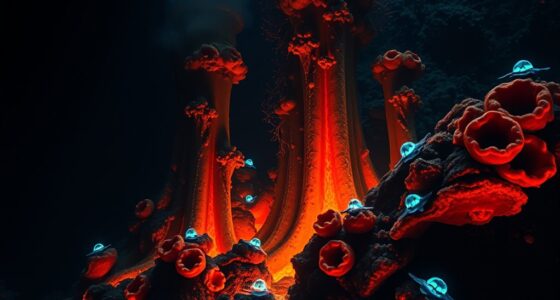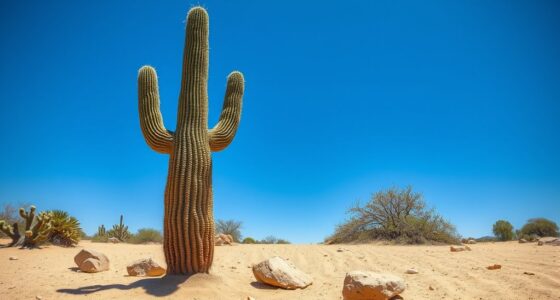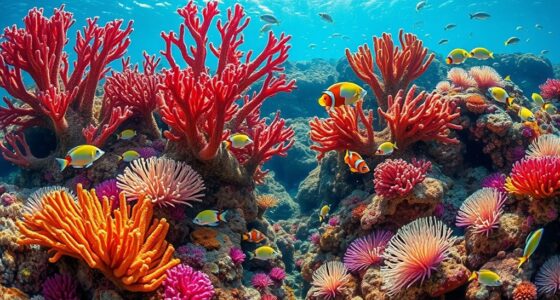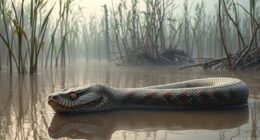As temperatures continue to rise, polar regions face rapid changes that could reshape global climate patterns. The melting ice sheets and shifting habitats threaten both wildlife and human communities. Understanding these transformations is crucial, yet many aspects remain uncertain. Exploring how these ecosystems are evolving offers essential insights into the broader impacts of climate change, prompting important questions about what lies ahead for these fragile environments.
The Impact of Rising Temperatures on Polar Ice Sheets
As global temperatures continue to rise, polar ice sheets are melting at an accelerating rate. You can see this happening through shrinking ice masses in both the Arctic and Antarctic.
Warmer air and ocean temperatures weaken the ice’s structure, causing it to break apart and thin out. This process exposes more ice to direct sunlight, which further accelerates melting.
As you observe these changes, you realize that the loss of ice impacts the planet’s energy balance, contributing to local and global warming. The faster melting reduces the reflective surface of ice, making it harder for the Earth to bounce sunlight back into space.
This cycle intensifies the warming, creating a feedback loop that worsens the impact of climate change on polar regions. Advanced sensors in modern ice monitoring technology help scientists track these rapid changes more accurately.
Melting Glaciers and Sea Level Rise
Have you ever wondered how the melting of glaciers directly affects sea levels? When glaciers in Greenland and Antarctica melt, they release massive amounts of water into the oceans. This added water causes sea levels to rise, threatening coastal communities worldwide.
As glaciers shrink, their ice no longer holds back ocean water, leading to gradual but significant increases in sea levels. Rising seas can erode shorelines, flood low-lying areas, and displace millions of people. The loss of ice also impacts ancient seed cultivation practices, as traditional farming methods in polar regions become less viable.
Additionally, the loss of ice accelerates global warming because less ice means less sunlight reflected back into space. Your actions, from reducing carbon emissions to supporting climate policies, can help slow this process and protect vulnerable regions from the devastating impacts of rising sea levels.
Shifts in Wildlife Migration and Habitats
Climate change is causing wildlife to alter their migration patterns and habitats at an unprecedented rate. You’ll notice animals arriving earlier or later than usual, trying to adapt to shifting temperatures and food sources. Many species are moving to higher altitudes or latitudes, seeking cooler environments. Caribou, penguins, and Arctic foxes are among those changing routes or expanding into new areas. These shifts disrupt established ecosystems, affecting predator-prey relationships and breeding cycles. Some animals struggle to keep pace with rapid changes, risking population declines or local extinction. As habitats transform, you might see new species colonizing areas previously uninhabited, while others become isolated. The rapid pace of change challenges wildlife to adapt quickly, risking the delicate balance of polar ecosystems. Understanding ecosystem balance is crucial to grasp how these shifts impact the overall health of these fragile environments.
Changes in Sea Ice Extent and Thickness
The shrinking and thinning of sea ice are direct responses to rising temperatures, significantly altering the polar landscape. As global warming accelerates, you’ll notice less ice covering the ocean during winter and more open water during summer.
This reduction in extent happens rapidly, with some regions losing up to 13% of sea ice per decade. Thinner ice makes the entire ecosystem more vulnerable, as it can’t support the same wildlife or withstand seasonal changes as effectively.
You’ll observe earlier melting periods and delayed refreezing, creating a fragile environment. Reduced ice cover impacts ocean circulation and heat exchange, further amplifying climate effects.
Additionally, changes in projector technology are enhancing our ability to study these remote environments through high-resolution imaging and data collection.
The Role of Permafrost in Arctic Stability
Permafrost acts as a vital stabilizer for the Arctic landscape, locking in vast amounts of organic material and groundwater beneath its frozen surface. This frozen layer prevents soil erosion, maintains the integrity of the ground, and supports vegetation growth. When permafrost remains intact, it helps regulate the region’s temperature and prevents the release of greenhouse gases. However, as temperatures rise, thawing occurs, causing ground instability and increasing the risk of landslides and infrastructure damage. The thaw also releases stored organic matter, which bacteria decompose into carbon dioxide and methane, further fueling climate change. You must understand that the stability of permafrost is crucial for maintaining the Arctic’s ecological balance and protecting the delicate environment from rapid, disruptive changes. Incorporating sound design techniques can help visualize and communicate these complex environmental processes more effectively.
Ocean Currents and Climate Feedback Loops
Ocean currents play a crucial role in regulating Earth’s climate by redistributing heat across the globe. As warm waters move toward polar regions, they help keep temperatures from plummeting too quickly.
Conversely, cold currents carry cooler water toward the equator, balancing global heat distribution. In polar regions, these currents influence ice melt and formation, creating feedback loops.
For example, when warm currents thaw ice shelves, they expose darker ocean surfaces, which absorb more heat and accelerate melting. This process can weaken thermohaline circulation, disrupting climate patterns worldwide.
Changes in ocean currents due to melting ice or shifting wind patterns can intensify warming in polar areas, fueling further ice loss. These feedback loops demonstrate how interconnected ocean circulation and climate are, with shifts in one directly impacting the other.
Additionally, the use of ocean current modulation techniques in climate models helps scientists better understand and predict these complex feedback mechanisms.
Human Activities and Their Effects on Polar Regions
Human activities have increasingly impacted polar regions, accelerating environmental changes that threaten their delicate ecosystems. As you explore these areas, you’ll see how industrial activities like oil drilling, mining, and shipping introduce pollutants and disturb habitats.
Climate change, driven by greenhouse gas emissions from fossil fuel use, causes rapid ice melt and rising sea levels, threatening species like polar bears and penguins.
Your fishing practices can disrupt food chains, while tourism brings pollution and habitat disturbance.
Additionally, increased military presence and infrastructure development cause further habitat fragmentation.
These human interventions intensify the effects of natural changes, pushing polar ecosystems toward critical thresholds.
Recognizing your role in these impacts helps highlight the importance of responsible actions and policies to protect these fragile environments. Remote hackathons offer innovative ways for scientists and environmentalists to collaborate globally on monitoring and developing solutions for polar conservation.
Future Projections and Conservation Challenges
As climate change accelerates, future projections for the polar regions reveal alarming environmental shifts that threaten their ecosystems. You’ll see rising temperatures cause sea ice to melt further, disrupting habitats for polar bears, seals, and penguins. Ocean acidification will intensify, threatening marine life and food webs. These changes will challenge conservation efforts, requiring innovative strategies and international cooperation. Protecting vulnerable species and habitats becomes more urgent as ecosystems become increasingly fragile. You must prioritize reducing greenhouse gas emissions globally to slow these impacts. Additionally, establishing protected areas and supporting indigenous-led conservation initiatives can help bolster resilience. The rise of marine biodiversity and the adaptation of species to changing conditions will also play a critical role in the ecosystems’ ability to recover and sustain themselves. While uncertainties remain, proactive measures are essential to prevent irreversible damage and preserve the polar regions’ unique ecosystems for future generations.
Conclusion
You can’t ignore how climate change is transforming polar regions. As ice melts and habitats shift, wildlife struggles to survive, and global ocean patterns change. Your actions matter—reducing emissions and supporting conservation efforts can help protect these fragile ecosystems. By staying informed and advocating for sustainable policies, you play a crucial role in slowing down these rapid changes. Together, we can work toward a healthier, more resilient Arctic and Antarctic for future generations.







